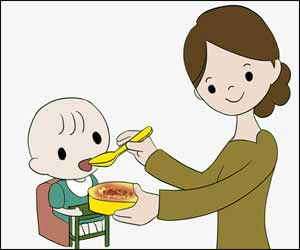- Home
- Editorial
- News
- Practice Guidelines
- Anesthesiology Guidelines
- Cancer Guidelines
- Cardiac Sciences Guidelines
- Critical Care Guidelines
- Dentistry Guidelines
- Dermatology Guidelines
- Diabetes and Endo Guidelines
- Diagnostics Guidelines
- ENT Guidelines
- Featured Practice Guidelines
- Gastroenterology Guidelines
- Geriatrics Guidelines
- Medicine Guidelines
- Nephrology Guidelines
- Neurosciences Guidelines
- Obs and Gynae Guidelines
- Ophthalmology Guidelines
- Orthopaedics Guidelines
- Paediatrics Guidelines
- Psychiatry Guidelines
- Pulmonology Guidelines
- Radiology Guidelines
- Surgery Guidelines
- Urology Guidelines
Baby foods have high sugar content and are inappropriately advertised: WHO report

WHO calls for a ban on certain baby food products having inappropriately high sugar content and are wrongly advertised. The report stated that a high proportion of baby foods are incorrectly marketed as suitable for infants under the age of 6 months and that many of those foods contain inappropriately high levels of sugar.
WHO developed a draft Nutrient Profile Model (NPM) for children aged 6–36 months to guide decisions about which foods are inappropriate for promotion for this age group. This was put forward to Member States and stakeholders for consideration and further discussion.
WHO/Europe also developed a methodology for identifying commercial baby foods available in retail settings, and for collecting nutritional content data on labels as well as other information from packaging, labelling and promotion (including claims).
This methodology was used to collect data on 7955 food or drink products marketed for infants and young children from 516 stores in 4 cites in the WHO European Region (Vienna, Austria; Sofia, Bulgaria; Budapest, Hungary; and Haifa, Israel) between November 2017 and January 2018.
According to the report, results in all four countries showed high levels of total sugars. In Austria, Bulgaria, and Hungary, in around half or more of products, more than 30% of energy was provided by sugars and more than four in 10 products had 40% or more of energy from sugars. In Israel, levels were lower; nonetheless, nearly one in five products (18%) had more than 30% of energy from sugars. Use of some kind of sweetening agent – most commonly “sugar” or “concentrated fruit juice” – was widespread, featuring in around a third or more of the products.
WHO’s long-standing recommendation states that children should be breastfed, exclusively, for the first 6 months. Its 2016 global Guidance on Ending the Inappropriate Promotion of Foods for Infants and Young Children explicitly states that commercial complementary foods should not be advertised for infants under 6 months of age.
“Good nutrition in infancy and early childhood remains key to ensuring optimal child growth and development, and to better health outcomes later in life – including the prevention of overweight, obesity and diet-related noncommunicable diseases (NCDs) – thereby making United Nations Sustainable Development Goal 3 to ensure healthy lives and promote well-being for all at all ages much more achievable,” says Dr Zsuzsanna Jakab, WHO Regional Director for Europe.
Although this is permitted under European Union law, it does not pay tribute to the WHO International Code of Marketing of Breastmilk Substitutes or the WHO Guidance. Both explicitly state that commercial complementary foods should not be marketed as suitable for infants under 6 months of age.
“Foods for infants and young children are expected to comply with various established nutrition and compositional recommendations. Nonetheless, there are concerns that many products may still be too high in sugars,” says Dr João Breda, Head of the WHO European Office for the Prevention and Control of Noncommunicable Diseases.
In 3 of the cities, half or more of the products provided over 30% of the calories from total sugars. Around a third of the products listed sugar, concentrated fruit juice or other sweetening agents as an ingredient. These added flavours and sugars could affect the development of children’s taste preferences by increasing their liking for sweeter foods.
Although foods such as fruits and vegetables that naturally contain sugars are appropriate for infants and young children, the very high level of free sugars in puréed commercial products also causes for concern.
The draft NPM for infants and young children was developed by following recommended WHO steps and was informed by data from several sources, including a literature review. It refers to existing European Commission directives and Codex Alimentarius standards and reflects the approach used for the WHO/Europe NPM for children over 36 months.
The draft NPM was validated against label information from 1328 products on the market in 3 countries in 2016–2017, and pilot-tested in 7 additional countries in 2018 with a further 1314 products.

Disclaimer: This site is primarily intended for healthcare professionals. Any content/information on this website does not replace the advice of medical and/or health professionals and should not be construed as medical/diagnostic advice/endorsement or prescription. Use of this site is subject to our terms of use, privacy policy, advertisement policy. © 2020 Minerva Medical Treatment Pvt Ltd